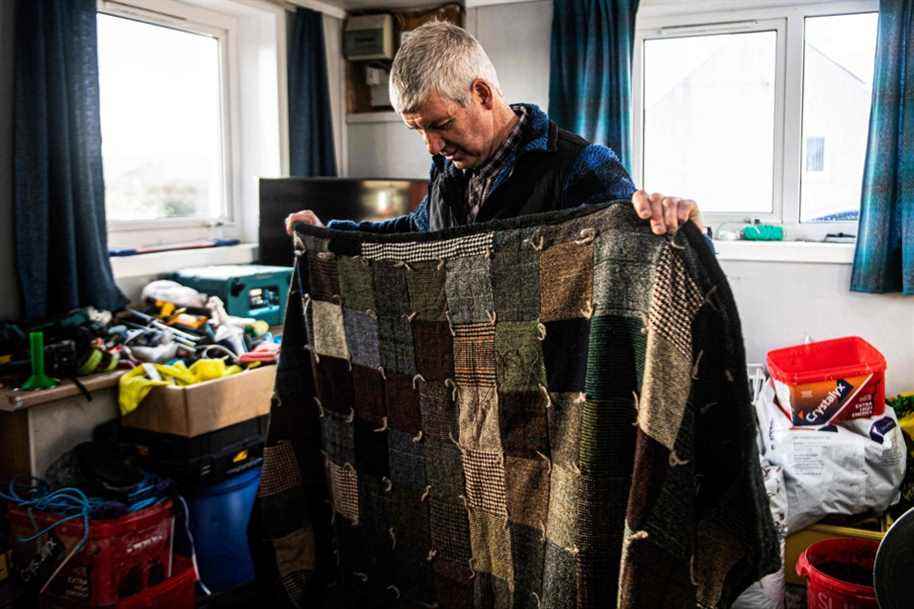(Isle of Lewis) In his small workshop cluttered with bags of fabrics, spools and tools, Ian Mackay patiently weaves a bright green wool. Once finished, the tweed made at his home in the Scottish Hebrides archipelago may be shipped halfway around the world.
For now, this 51-year-old weaver is pedaling to activate the weaving machine with a regular click, watching for any faults.
“It’s hand-woven… Well, as you can see, it’s rather woven with the feet,” he jokes in a voice marked by a strong Hebridean accent.
The fifty-something spins wool ten hours a day, only taking a break on Sunday, a sacred day in this Scottish archipelago of some 26,000 inhabitants bathed in the Christian religion.
“There is no point in being very fast and making mistakes. Better to do slow, quality work, ”he suggests.
“It doesn’t matter how bad the weather is when you’re weaving,” he also remarks as an icy wind outside whips the ocher-hued moor where sheep graze.
Originally from Scotland and marketed since the 1840s, tweed is more than ever on the rise: its ecological and sustainable aspect inspires designers concerned with being more respectful of the environment.
Traditionally made from 100% pure new sheep’s wool, Harris tweed is the only fabric protected by a 1993 law of the British Parliament. , in the Outer Hebrides […], from pure new wool dyed and spun in the Outer Hebrides ”.
Affixed to each piece, a logo made up of a globe surmounted by a cross certifies the origin and authenticity of this fabric.
Ecological and sustainable

PHOTO ANDY BUCHANAN, FRANCE-PRESS AGENCY
Ian Mackay spins wool ten hours a day, allowing himself a break only on Sunday, a sacred day in this Scottish archipelago of some 26,000 inhabitants bathed in the Christian religion.
If it is originally associated with the aristocracy and gentlemen-farmers who prized its weather-resistant character, ideal for a hunting or fishing trip, the British designer Vivienne Westwood has long diverted this image into the integrating into the punk locker room.
Like her, other big brands make it a key part of their collections.
“We are fortunate to work with the most prestigious fashion houses in the world […] like Chanel, Dior, Yves Saint Laurent, Hermès, ”quotes Margaret Macleod, sales manager for Harris Tweed Hebrides. “We have done a lot of work with Polo Ralph Lauren in the United States recently,” she adds, showing a tour of the company’s lakeside factory in Shawbost, western England. Isle of Lewis.
Seventy people work in this tweed factory. The wool is dyed and spun there, then sent to some 120 home weavers. Once the tweed is woven, it will return to the factory to be washed, dried and undergo the final finishing touches.
One third of the Shawbost factory’s output goes to the UK while two thirds are exported to all corners of the world.
“We export intensively to France, Germany, Italy and many other countries in Europe. We also have strong export activities in South Korea, Japan and the United States, and China has also become a new market, ”says the sales manager.
From Chanel to Nike

PHOTO ANDY BUCHANAN, FRANCE-PRESS AGENCY
Everyone wears tweed which comes in dozens of different patterns and shades: moss green, indigo, cherry red, daffodil.
In total, some 160 home weavers live in the Hebrides, working hand in hand with three factories that produce a total of 1.5 million meters per year.
Tweed is used in the manufacture of jackets, pants, coats, but also shoes, handbags, armchairs or even teddy bears.
About fifteen years ago, the mark of sportswear Nike had chosen the Harris tweed for a collection of “trainers”, a huge publicity stunt for the craftsmen of the Hebrides.
More recently, the public has rediscovered him thanks to very popular television series: Aristocrats of Downton abbey to the gangsters Peaky blinders passing by the royal family in The Crown, everyone wears tweed which comes in dozens of patterns (checks, chevrons, houndstooth, etc.) and different shades.
Moss green, indigo, cherry red, daffodil… “We start with around 60 colors and mix each of those colors to create over 180 different shades of yarn,” describes Margaret Macleod.
A range of colors inspired by the landscape of these remote islands, from the golden browns of the moor to the blue of the Atlantic Ocean.
According to Mme Macleod, stylists are drawn to ‘colors’ and ‘authenticity’, and ‘they also want to capture a little bit of the Outer Hebrides’.
